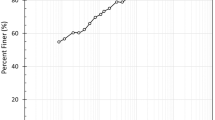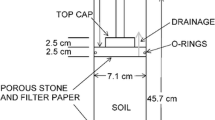Abstract
The effects of loading histories on small-strain and large-strain stiffness of a compacted cement-mixed well-graded gravelly soil were evaluated by consolidated drained triaxial compression (TC) tests. Various cyclic loading histories were applied during otherwise continuous monotonic loading at different confining pressures, σ hs, and multiple-step loading with stepwise increase or decrease of σ h. To evaluate small-strain stiffness, minute unload/reload cycles were applied during TC loading. The value of peak-to-peak secant modulus from a minute unload/reload cycle was defined as the equivalent Young’s modulus, E eq. The average of E eq values measured during continuous monotonic loading at low deviator stresses was rather close to the elastic modulus, E e. As the E e increased with an increase in the axial stress, the E eq value increased first and then decreased due to an increase in creep strains. The stress–strain behaviour after the start of a large-scale yielding and the peak shear strength is not noticeably affected by the previous cyclic loading with relatively large stress amplitude. However, the large-strain stiffness during reloading is significantly affected by the following factors controlled by pre-cyclic loading history; (a) strain hardening; (b) strain nonlinearity; (c) hysteresis effect; (d) viscous effect; and (e) damage to bonding by immediately preceding large unloading. The tangent stiffness, E tan, at a given stress level during reloading becoming larger with an increase in the effects of factor (a) and smaller by the effects of factors (b), (c), (d) and (e). In addition, increase of σ h has a negative effect on stiffness of primary loading curves and a positive effect on stiffness of reloading curves. The effect of loading history on the small-strain stiffness in terms of equivalent Young’s modulus, E eq, was found to be significant. This effect depends on various factors. Four factors—axial stress level, strain-hardening effect, creep effect by the viscous properties and damage due to a loading history—were identified to be responsible for equivalent Young’s modulus, E eq variations. Axial stress increase and strain-hardening effect both increase E eq, making E eq closer to the E e. However, creep strains by the viscous properties and damage due to a loading history both decrease E eq.


























Similar content being viewed by others
References
Aoki H, Yonezawa T, Watanabe O, Tateyama M, Tatsuoka F (2003) Results from field full-scale loading tests on a bridge abutment with backfill of geogrid-reinforced cement-mixed gravel. Geosynth Eng J Jpn Chapter Int Geosynth Soc 18:237–248 (in Japanese)
Atkinson JH, Richardson D, Stallebrass SE (1990) Effect of recent stress history on the stiffness of overconsolidated soil. Géotechnique 40:531–540
Chang WF (1988) A demonstration project: roller compacted concrete utilization phosphogypsum. University of Miami
Fortuna S, Callisto L, Rampello S (2006) Small strain stiffness of a soft clay along stress paths typical of excavations. In: Soil stress–strain behavior: measurement, modeling and analysis geotechnical symposium in Rome
Goto S, Tatsuoka F, Shibuya S, Kim YS, Soto T (1991) A simple gauge for local small strain measurements in the laboratory. Soils Found 31(1):169–180
Hansen KD, Reinhardt WG (1990) Roller-compacted concrete dams. McGraw-Hill Inc., New York
Hayano K, Sato T, Tatsuoka F (1997) Deformation characteristics of a sedimentary soft rock from triaxial compression tests rectangular prism specimens. Géotechnique 47(3):439–449
JGS (2001) Triaxial compression test on soft rock. Jap. Geotech. Standard, JGS 2533-2001
Jovicic V, Coop MR (1997) Stiffness of coarse-grained soils at small strains. Géotechnique 47:357–362
Kongsukprasert L, Tatsuoka F (2003) Viscous effects coupled with aging effects on the stress–strain behavior of cement-mixed gravel. In: Dia Benedetto et al (eds) Proceedings of the 3rd international conference on pre-failure deformation characteristics of geomaterials, vol 1. Lyon, Balkema, pp 569–577
Kongsukprasert L, Tatsuoka F, Tateyama M (2005) Several factors affecting the strength and deformation characteristics cement-mixed gravel. Soils Found 45(3):107–124
Kongsukprasert L, Tatsuoka F (2005) Ageing and viscous effects on the deformation and strength characteristics on cemented-mixed gravelly soil in triaxial compression. Soils Found 45(6):55–74
Kongsukprasert L, Tatsuoka F (2007) Small strain stiffness and non-linear stress–strain behavior of cemented-mixed gravelly soil. Soils Found 47(2):375–394
Lohani TN, Kongsukprasert L, Watanabe K, Tatsuoka F (2004) Strength and deformation properties of cemented-mixed gravel evaluated by triaxial compression tests. Soils Found 44(5):95–108
Santucci de Magistris F, Koseki J, Amaya M, Hamaya S, Sato T, Tatsuoka F (1999) A triaxial testing system to evaluate stress–strain behaviour of soils for wide range of strain rate. Geotech Test J ASTM 22(1):44–60
Schrader EK (1996) Compaction of roller compacted concrete. ACI Spec Publ SP96-6:77–101
Taheri A, Sasaki Y, Tatsuoka F, Watanabe K (2012) Strength and deformation characteristics of cemented-mixed gravelly soil in multiple-step triaxial compression. Soils Found 52(1):151–170
Tatsuoka F, Kohata Y, Ochi K, Kim YS, Shi D (1993) Measuring small strain stiffness of soft rocks. Geotechnical engineering of hard soils–soft rocks, Balkema
Tatsuoka F, Kohata Y (1995) Stiffness of hard soils and soft rocks in engineering applications, keynote lecture. In: Shibuya et al (eds) Proceedings of the international symposium pre-failure deformation of geomaterials, Balkema, vol 2, pp 947–1063
Tatsuoka F, Uchida K, Ouchi T, Kohata Y (1997) Properties of cement-treated soils in Trans-Tokyo Bay Highway project. Gr Improv Thomas Telford 1(1):37–58
Tatsuoka F, Jardine RJ, Lo Presti D, Di Benedetto H, Kodaka T (1999a) Characterization the pre-failure deformation properties of geomaterials, theme lecture for the plenary session no. 1, vol 4. In: Proceedings of the 14th ICSMFE, Hamburg, pp 2129–2164
Tatsuoka F, Modoni G, Jiang GL, Dan LQA, Flora A, Matsushita M, Koseki J (1999b) Stress–strain behaviour at small strains of unbound granular materials and its laboratory tests, keynote lecture. In: Correia (ed) Proceedings of the workshop on modeling and advanced testing for unbound granular materials, Lisboa, Balkema, pp 17–61
Tatsuoka F, Hayano K, Koseki J (2003a) Strength and deformation characteristics of sedimentary soft rock in the Tokyo metropolitan area. In: Proceedings of characterization and engineering properties of natural soils, Swets and Zeitlinger, pp 1461–1525
Tatsuoka F, Masuda T, Siddiquee MSA, Koseki J (2003) Modeling the stress–strain relations of sand in cyclic plane strain loading. J Geotech Geoenviron Eng 129(6):450–467
Tatsuoka F, Nawir H, Kuwano R (2004) A modeling procedure of shear yielding characteristics affected by viscous properties of sand in triaxial compression. Soil Found 44(6):83–99
Tatsuoka F, Hirakawa D, Nojiri M, Aizawa H, Nishikiori H, Soma R, Tateyama M, Watanabe K (2009) A new type integral bridge comprising geosynthetic-reinforced soil walls. Geosynth Int IS Kyushu 2007 Spec Issue 16(4):301–326
Wang Y, Ng CWW (2005) Effects of stress paths on the small-strain stiffness of completely decomposed granite. Can Geotech J 42:1200–1211
Watanabe K, Tateyama M, Jiang G, Tatsuoka F, Lohani TN (2003a) Strength characteristics of cement-mixed gravel evaluated by large triaxial compression tests. In: Di Benedetto H et al (eds) Proceedings of the 3rd international conference on pre-failure deformation characteristics of geomaterials, vol 1. Lyon, Balkema, pp 683–693
Watanabe O, Nasu Y, Aoki H, Yonezawa T, Tateyama M, Tatsuoka F (2003b) Construction control of approach block of cemented mixed gravel backfill. In: Proceedings of the 58th annual conference on Japanese society for civil engineers, vol 3. Tokushima, pp 1091–1092 (in Japanese)
Acknowledgments
The first author is grateful to the Japan Society for the Promotion of Science for the fellowship (ID No. P08392) supporting this research.
Author information
Authors and Affiliations
Corresponding author
Rights and permissions
About this article
Cite this article
Taheri, A., Tatsuoka, F. Small- and large-strain behaviour of a cement-treated soil during various loading histories and testing conditions. Acta Geotech. 10, 131–155 (2015). https://doi.org/10.1007/s11440-014-0339-7
Received:
Accepted:
Published:
Issue Date:
DOI: https://doi.org/10.1007/s11440-014-0339-7




